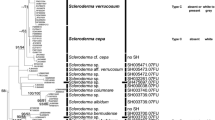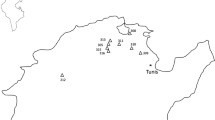Abstract
Sclerotinia sclerotiorum is a worldwide pathogen with a broad host spectrum pathogenic to around 400 plant species. Sclerotia formed by S. sclerotiorum serve as resting structures that secure fungal survival in soil for prolonged periods in the absence of a host plant or may help to overcoming periods of unsuitable growth conditions. In the present study, the morphological development of sclerotia was examined by light and scanning electron microscopy of fungal microcultures. Observations from microscopy indicated that, during the first 4 days of culture, the sclerotial primordial originate by dichotomous branching of apical hyphae and from the 5th day mycelial clusters were also observed, indicating the initiation stage of sclerotia formation. From the 6th to the 8th day, sclerotia turned from white to dark color, and water drops (exudates) were observed on their surface. The process of sclerotia formation ended at the 9th day when they were easy to detach from the culture medium and had a black coloration. All the morphological processes involved in the formation of sclerotia by S. sclerotiorum were observed with both light and scanning electron microscopy.





Similar content being viewed by others
References
Arseniuk E, Macewicz J (1994) Scanning electron microscopy of sclerotia of Sclerotinia trifoliorum and related species. J Phytopathol 141:275–284
Backhouse D, Stewart A (1987) Anatomy and histochemistry of resting and germinating sclerotia of Sclerotium cepivorum. Trans Br Mycol Soc 89:561–567
Bolton MD, Thomma BPHJ, Nelson BD (2006) Sclerotinia sclerotiorum (Lib) de Bary: biology and molecular traits of a cosmopolitan pathogen. Mol Plant Pathol 7:1–16
Bullock S, Willetts HJ (1996) Ultrastructural and histochemical studies on mycelial germination of sclerotia of Sclerotinia minor. Mycol Res 100:561–570
Chet I (1975) Ultrastructural basis of sclerotial survival in soil. Microb Ecol 2:194–200
Chet I, Henis Y (1975) Sclerotial morphogenesis in fungi. Annu Rev Phytopathol 13:169–192
Colotelo N (1974) A scanning electron microscope study of developing sclerotia of Sclerotinia sclerotiorum. Can J Bot 52:1127–1130
Cooke RC (1970) Physiological aspects of sclerotium growth in Sclerotinia sclerotiorum. Trans Br Mycol Soc 54:361–365
Ekins MG, Aitken EAB, Goulter KC (2005) Identification of Sclerotinia species. Australas Plant Pathol Soc 34:549–555
Erental A, Dickman MB, Yarden O (2008) Sclerotial development in Sclerotinia sclerotiorum: awakening molecular analysis of a “Dormant” structure. Fungal Biol Rev 22:6–16
Fernando WGD, Nakkeeran S, Zhang Y (2004) Ecofriendly methods in combating Sclerotinia sclerotiorum (Lib.) de Bary. Recent Res Dev Environ Biol 1:329–347
Garg H, Li H, Sivasithamparam K, Kuo J, Barbetti MJ (2010) The infection processes of Sclerotinia sclerotiorum in cotyledon tissue of a resistant and susceptible genotype of Brassica napus. Ann Bot 106:897–908
Hegedus DD, Rimmer SR (2005) Sclerotinia sclerotiorum: When “to be or not to be” a pathogen? FEMS Microbiol Lett 251:177–184
Ordóñez-Valencia C, Alarcón A, Ferrera-Cerrato R, Hernández-Cuevas LV (2009) In vitro antifungal effects of potassium bicarbonate to Trichoderma sp. and Sclerotinia sclerotiorum. Mycoscience 50:380–387
Riddell RW (1950) Permanent stained mycological preparation obtained by slide culture. Mycologia 42:265–270
Rollins JA, Dickman MB (1998) Increase in endogenous and exogenous cyclic AMP levels inhibits sclerotial development in Sclerotinia sclerotiorum. Appl Environ Microbiol 64:2539–2544
Sadeh R, Kritzman G, Chet I (1985) The ultrastructure of resting and germinating sclerotia of Botrytis allii. Bot Gaz 146:302–307
Saharan GS, Mehta N (2008) Sclerotinia diseases of crop plants: biology, ecology and disease management. Springer, Dordrecht
Townsend BB, Willetts HJ (1954) The development of sclerotia of certain fungi. Trans Br Mycol Soc 37:213–221
Willetts HJ, Bullock S (1992) Developmental biology of sclerotia. Mycol Res 96:801–816
Willetts HJ, Wong AL (1971) Ontogenetic diversity of sclerotia of Sclerotinia sclerotiorum and related species. Trans Br Mycol Soc 57:515–524
Willetts HJ, Wong AL (1980) The biology of Sclerotinia sclerotiorum, S. trifoliorum, and S. minor with emphasis on specific nomenclature. Bot Rev 46:101–165
Wong AL, Willetts HJ (1975) A taxonomic study of Sclerotinia sclerotiorum and related species: mycelial interactions. J Gen Microbiol 88:339–344
Wu BM, Subbarao KV (2006) Analyses of lettuce drop incidence and population structure of Sclerotinia sclerotiorum and Sclerotinia minor. Phytopathology 96:1322–1329
Zarani F, Christias C (1997) Sclerotial biogénesis in the basidiomycete Sclerotium rolfsii. A scanning electron microscope study. Mycologia 89:598–602
Acknowledgments
This research was partially supported by the National Council for Science and Technology (CONACYT, Mexico) by the following grants: SEP-CONACYT 58594 and SEP-CONACYT 130262. Claudia Ordóñez-Valencia is grateful for financial support during her PhD studies.
Author information
Authors and Affiliations
Corresponding author
Rights and permissions
About this article
Cite this article
Ordóñez-Valencia, C., Ferrera-Cerrato, R., Quintanar-Zúñiga, R.E. et al. Morphological development of sclerotia by Sclerotinia sclerotiorum: a view from light and scanning electron microscopy. Ann Microbiol 65, 765–770 (2015). https://doi.org/10.1007/s13213-014-0916-x
Received:
Accepted:
Published:
Issue Date:
DOI: https://doi.org/10.1007/s13213-014-0916-x




